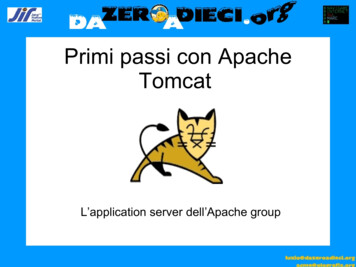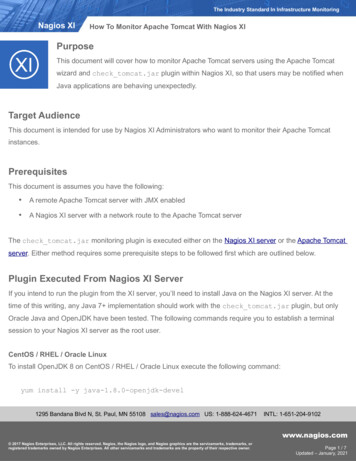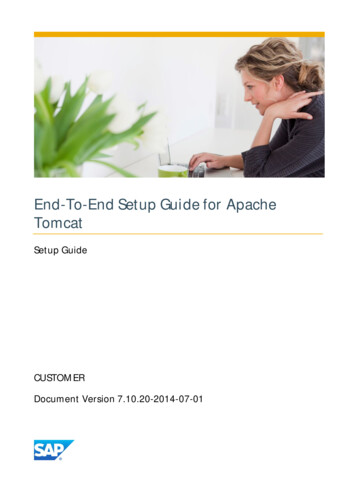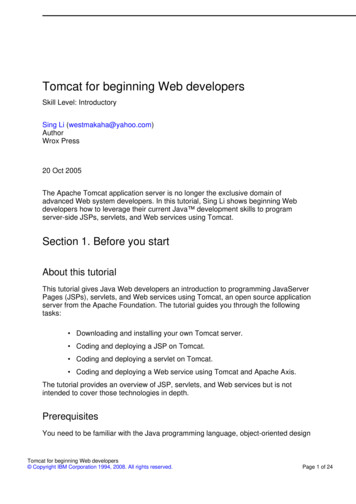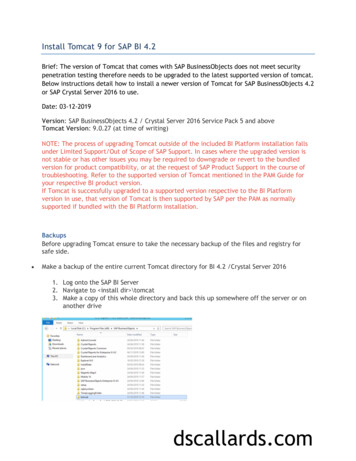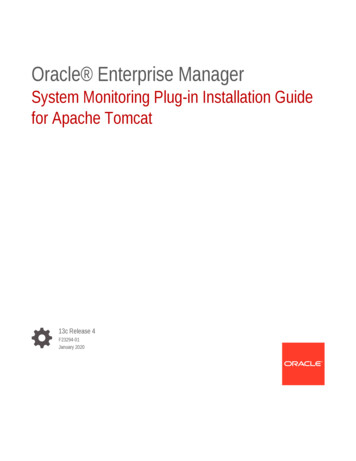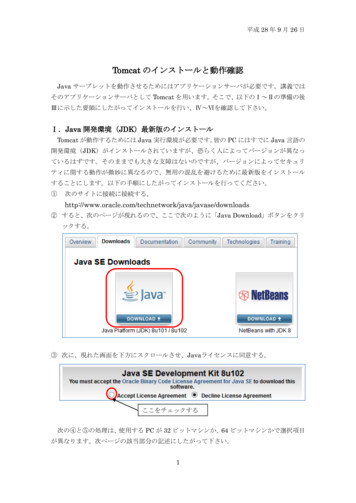
Transcription
Choosing Tomcat ConnectorsJean-Frederic Clere
What I will cover Who I am. Connectors JIO, NIO, NIO2, APR AJP/HTTP Proxy AJP/HTTPPerformances tests With ab or customized client load generator.Questions?11/18/142
Who I amJean-Frederic ClereRed HatResponsible of JWS product.Years writing JAVA code and server softwareTomcat committer since 2001Doing OpenSource since 1999Cyclist/Runner etcLived 15 years in Spain (Barcelona)Now in Neuchâtel (CH)11/18/143
Remote location11/18/144
Red Hat Office Neuchâtel11/18/145
Protocol basic HTTP/1.1 request Responses: Normal Chunked Upgrade (to websocket for example) Proxy AJP/HTTP11/18/146
Request HTTP/1.1POST /comet/CometServletTest1 HTTP/1.1\nUser-Agent: testclient\nHost: localhost\nTransfer-Encoding: chunked\n11/18/147
Response for exampleChunked:HTTP/1.1 200 OK\nServer: Apache-Coyote/1.1\nSet-Cookie: JSESSIONID obcoR30qlz7DMJfZmsVTt Uv; Path /comet\nTransfer-Encoding: chunked\nDate: Mon, 07 Nov 2011 22:09:33 GMT\nUpgrade:HTTP/1.1 101 Switching ProtocolsUpgrade: websocketConnection: UpgradeSec-WebSocket-Accept: HSmrc0sMlYUkAGmm5OPpG2HaGWk Sec-WebSocket-Protocol: chat11/18/148
What is a Connector? Tomcat's interface to the world Binds to a port Understands a protocol Dispatches requests protocol "org.apache.coyote.http11.Http11Protocol" protocol "org.apache.coyote.http11.Http11AprProtocol" protocol "org.apache.coyote.http11.Http11NioProtocol" protocol "org.apache.coyote.http11.Http11Nio2Protocol"
Tomcat Connectors Java Blocking I/O (BIO or sometimes JIO) Java Non-blocking I/O (NIO) Native / Apache Portable Runtime (APR) Java NIO.2Technically, there are combinations of all of the above with HTTP and AJP protocols.We’ll discuss those a bit later.
Types of I/O Polling Straightforward API: peek() CPU-inefficient Thread loops while waiting for dataBlocking Straightforward API: read() CPU-efficient (blocks) Thread stalls while waiting for data11/18/14
Types of I/O Non-blocking Complicated API (registration, event callbacks) Channel Buffer Selector CPU-efficient Thread not required to: execution continues When data is ready, the selector notifies observers11/18/14
Common Connector Features Support for all protocols HTTP, AJP, Websocket Support for all dispatch methods Standard, Comet, Servlet 3.0 async Support for HTTPS (SSL/TLS) Acceptor thread(s) call accept() and hand-off Request processor thread pool11/18/14
Blocking I/O Connector (1) All I/O operations are blocking in processor thread SSL handshake Read request line (e.g. GET, POST, etc.) Read request body Write response Read next request (HTTP keep-alive)Simple, stable, mature11/18/14
Blocking I/O Connector (2) Single thread handles request straight-through, afteracceptUses Java Secure Sockets Extension (JSSE) for SSL/TLS11/18/14
Blocking I/O Connector (3) Request throughput limited by thread count Clients can waste threads Slow request line (mobile) Aborted keep-alive stalls thread (default 20sec!)Unfair: accepted connections get priority for keep-aliverequests11/18/14
NON-Blocking I/O Connector(1) Single thread handles request after request-line Poller thread(s) manage non-blocking Selector Read SSL handshake Read request line Wait for next keep-alive request11/18/14
NON-Blocking I/O Connector(2) Block poller simulates blocking Request header/body reads Response writes Processor thread sleeps during sim-blocking Uses JSSE for SSL/TLS Supports sendFile11/18/14
NON-Blocking I/O Connector(3) Allows huge number of parallel requests Not limited by request-processor threads Slow clients do not stall threads Aborted keep-alives die in the poller queue Simulated blocking adds overhead11/18/14
Native Connector (APR) (1) Single thread handles request after accept() Poller thread(s) handle certain I/O reads Wait for next keep-alive requestSome I/O operations block processor thread SSL handshake Read request line Read request body Write response11/18/14
Native Connector (APR) (2) Uses OpenSSL for SSL/TLS Supports sendFile11/18/14
Native Connector (APR) (3) Request throughput limited by thread count Slow clients can stall threads Aborted keep-alives die in the poller queue OpenSSL offers performance advantage Native code risks JVM instability11/18/14
“Non-blocking” I/OConnector NIO.2 (1) Single thread handles request after request-lineThe thread are handled via anAsynchronousChannelGroup and completion call backs Read SSL handshake Read request line and headers Wait for next keep-alive request11/18/14
“Non-blocking” I/OConnector NIO.2 (2) NIO2 implementation takes care of blocking using Futureobjects waiting for IO Request body reads Response writes Processor thread sleeps during blockingUses JSSE for SSL/TLSIt emulates sendFile (NIO1 transferTo doesn't work withNIO2)11/18/14
“Non-blocking” I/OConnector NIO.2 (3) Allows huge number of parallel requests Not limited by request-processor threadsSlow clients do not stall threadsHigh level of abstraction and blocking over async addsoverheadNIO 2 provides blocking capabilities over its async IO. Thetomcat code is simpler (good) but an overhead still exists.11/18/14
Technical constraints Don’t try bother using non-blocking protocols with blockingconnectors (BIO Websocket bad) AJP can be thought of as 100% keep-alive AJP doesn’t support HTTP upgrade Use of sendFile is highly recommended for any staticcontent (APR or NIO.1)11/18/14
Connector Performance Compare connector throughput against each other Only static content was compared, varying file sizes Run on fast machines, 10 Gbps local network Tests: Compare the connectors (tc8.0.14) with httpd (2.2.22) noSSL. Same with SSL What about using a proxy: compare proxies.11/18/14
Connector Throughput (c4)700000600000coyote aprcoyote niocoyote nio nscoyote apr iB.bin32MiB.bin8MiB.bin
Connector CPU Use (c4)504540coyote aprcoyote niocoyote nio nscoyote apr 28KiB512KiB2MiB8MiB32MiB
Connector Throughput (c40)700000600000coyote aprcoyote niocoyote nio nscoyote apr iB.bin32MiB.bin8MiB.bin
Connector CPU Use (c40)8070coyote aprcoyote niocoyote nio nscoyote apr 8KiB512KiB2MiB8MiB32MiB
Connector Throughput (c80)700000600000coyote aprcoyote niocoyote nio nscoyote apr iB.bin32MiB.bin8MiB.bin
Connector CPU Use (c80)8070coyote aprcoyote niocoyote nio nscoyote apr 8KiB512KiB2MiB8MiB32MiB
Connector Performance Intermediate conclusion: Using sendfile helps a little. (but just emulated in NIO2!) So using JIO/BIO is probably an “old” idea.11/18/14
SSL Connector Throughput(c4)700000600000500000coyote apr nscoyote nio2 nscoyotecoyote nio nshttpd MiB.bin
SSL Connector CPU Use (c4)605040coyote apr nscoyote nio2 nscoyotehttpd iB32MiB
SSL Connector Throughput(c40)700000600000500000400000coyote apr nscoyote nio2 nscoyotehttpd n
SSL Connector CPU Use(c40)12010080coyote apr nscoyote nio2 nscoyotehttpd iB32MiB
Connector Performance Intermediate conclusion: OpenSSL performs better that JSSE JIO/BIO and NIO(2) give similar results.11/18/14
Proxy Throughput (c4)700000600000500000httpd sslhttpdmod jkproxy ajpproxy httpssl mod jkssl proxy ajpssl proxy 2MiB.bin
HTTPD CPU Use (c4)7060httpd sslhttpdmod jkproxy ajpproxy httpssl mod jkssl proxy ajpssl proxy MiB8MiB32MiB
SSL Proxy CPU Use (c4)70605040httpd sslssl mod jkssl proxy ajpssl proxy MiB32MiB
Proxy Throughput (c40)600000500000400000mod jkproxy ajpproxy httpssl mod jkssl proxy ajpssl proxy in
Proxy CPU Use (c40)12010080mod jkproxy ajpproxy httpssl mod jkssl proxy ajpssl proxy MiB32MiB
Connector/ProxyWhat use? Conclusion: If you need SSL better use a proxy Basically any “httpd proxy” will do the work. Use mod jk if you need a Swiss knife configuration. Use http otherwiseWebSocket Use httpd-2.4.x for mod proxy wstunnel.11/18/14
Questions?Thank you! jfclere@gmail.com users@tomcat.apache.org Repo with the scripts for the tests: https://github.com/jfclere/AC2014scripts11/18/14
Choosing tomcatconnectors
11/18/14 "Non-blocking" I/O Connector NIO.2 (3) Allows huge number of parallel requests Not limited by request-processor threads Slow clients do not stall threads High level of abstraction and blocking over async adds overhead NIO 2 provides blocking capabilities over its async IO. The tomcat code is simpler (good) but an overhead still exists.
